Serbia 2014 "Science"
| <prev | back to index | next> |
| Issue Date | 08.10.2014 |
| ID | Michel: 567-568; Scott: 675-676; Stanley Gibbons: 687-688 Yvert et Tellier: 562-563 Category: pP |
| Design | Boban. Savic |
| Stamps in set | 2 |
| Value | RSD 23 - Petar Stevanovic (geologist and paleontologist) RSD 74- Josif Pancica (botanist) |
| Emission/Type | commemorative |
| Places of issue | Belgrade |
| Size (width x height) | 30.0 mm x 37.50 mm |
| Layout | Two sheets 10 stamp each (5x2) |
| Products | FDC x2, MS x2 |
| Paper | |
| Perforation | 13.25 x 13.25 |
| Print Technique | Offset, multicolor |
| Printed by | ZIN Belgrade |
| Quantity | 25.000 each |
| Issuing Authority | Public Enterprise of PTT Srbija |
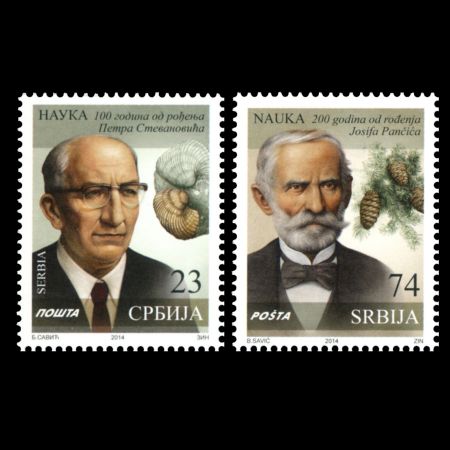
On October 8th, 2014, the Post Authority of Serbia in cooperation with the Natural History Museum of Belgrade, issued the set of 2 stamps, in the series "Science", to commemorate Centenary of geologuit and paleontologist Petar Stefanovic (1914-1999) and Bicentenary of botanist Josif Pancic (1814-1888).
The text about both scientists is based on the text published on the reverse side of the FDC covers. The text about fossilized shells of shellfish Lymnocardium sp. is based on other sources.
PETAR STEVANOVIC (1914–1999), was professor of geology at the University of Belgrade, member of the Serbian Academy of Sciences and Arts, President of the Serbian Geological Society and scientist with high international reputation, was the last student of the prominent Serbian geologist Jovan Zujovic.
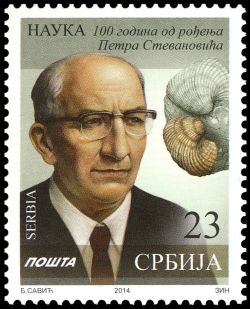
|
| Petar Stevanovic professor of geology, paleontologist on stamp of Serbia 2014, MiNr.: 567, Scott: 675. |
The period of World War II (1941-1945), Stevanovic spent imprisoned in the Osnabruck labour camp, Germany. Pedagogical and scientific activities commenced at the Faculty of Philosophy in Belgrade in 1946. Stevanovic defended his PhD thesis “The Lower Pliocene of Serbia and neighbouring areas” at the Moscow Paleontological Institute (USSR) in 1948. He lectured on the following subjects: Introduction to independent geological-paleontological investigations, Stratigraphy of Yugoslavia, the Quaternary geology. Petar Stevanovic was the author of the textbooks: "Historical Geology II-the Paleozoic Periods", "Historical Geology-the Cenozoic Periods and the Quaternary Geology".
In the field of Neogene stratigraphy of Pannonian Basen, he has introduced the two new substages (time-intervals), the Portaferrian (the Upper Pontian) and the Serbian (the Upper Pannonian) and identified forty taxa, new to science (bivalve and gastropod species and subspecies). During his long-lasting geological field research, he discovered new fossiliferous localities of different geological age in the Belgrade area, Kolubara Basin, Kostolac, Krupanj, Koceljeva, Loznica and Timočka krajina.
Good knowledge of several languages (Russian, French, German) enabled Stevanovic to follow successfully the achievements in geosciences and to participate in many international expert teams and committees. His first scientific article was issued in 1937, and up to 1999. During his career Stevanovic published more than 200 scientific and professional papers. He was appointed as a member of the Yugoslav Academy of Sciences and Arts, the Slovenian Academy of Sciences and Arts, and the Academy of Sciences of Bosnia and Herzegovina, as well as the honorary member of the Hungarian Geological Society and the Paleontological Society of the German Federal Republic.
Stevanovic's successful and fruitful work has been awarded by several orders and rewards (Order of Labor with the Golden Wreath, two October Prizes of City of Belgrade, “Seventh July Prize”). Owing to the great working capacity and self-discipline, he has achieved excellent scientific outcomes and made significant contributions to: developing and enhancing the geology school and geological education in Serbia, teaching and training of generations of geologists and paleontologists promoting and popularizing the geology and geosciences; developing the museology, and conserving and preserving the geological heritage of Serbia.
Two fossilized shells of shellfish Lymnocardium sp. can be seen on the top-right side of the stamp of Petar Stevanovic, First-Day-of-Issue Postmark and on the cachet of the FDC with stamp of Petar Stevanovic.
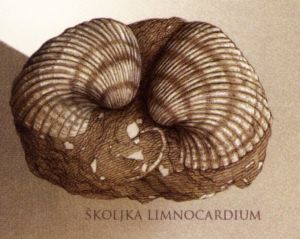 |
| Shellfish Limnocardium on the cachet of the FDC of Serbia 2014. |
This collection includes over 300.000 fossilized invertebrate remains, mostly of Tertiary age, from the territory of Balkans, Czech Republic, Austria, Hungary, Romania, Italy and Iran. It was established in 1939 as a legacy of Academy Member Petar Stevanovic (1914-1999), who spent first several years of his long working life at the Natural History Museum. The best represented group is of Neogene age (up to 15 million years ago). Besides the mollusks, this collection also includes fossilized remains of other invertebrate groups (trilobites and crinoids, several million years ago) well as microfauna, etc.
The youngest specimens in geological sense are representatives of Quaternary mollusks (up to several tens of years ago). As Petar Stevanovic spent most of his working life at Faculty of Mining and Geology, the collection also includes the material collected for students’ Bachelor Theses. Most important part of the collection includes the holotypes of taxa new for science, as well as the rare species.
Most of the collection was used to prepare the edition Geology of Serbia (1977) as well as other expert and scientific works, primarily in the fields of stratigraphy and paleontology, but also paleoecology, paleogeography etc.
JOSIF PANCICA (Ugrine: 1814 - Belgrade: 1888)
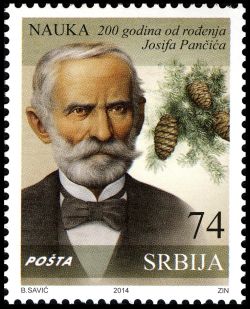 |
| Botanist Josif Pancic on stamp of Serbia 2014, MiNr.: 568, Scott: 676. |
Products and associated philatelic items
| FDC | First-Day-of-Issue Postmark | Mini-Sheets |
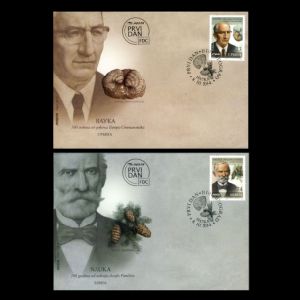 |
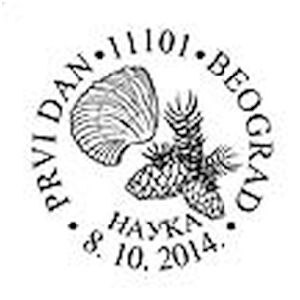 |
 |
| The reverse side is here | ||
| Circulated FDC | ||
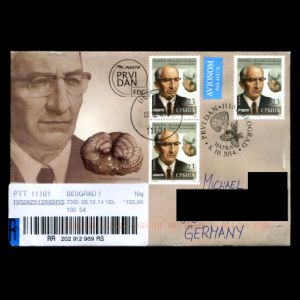 |
 |
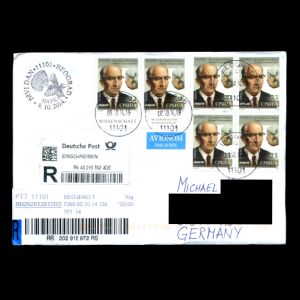 |
| The FDC was posted as a registered letter on the stamp issue date: 08.10.2014 with three stamps of paleontologist Petar Stevanovic and fossil of shellfish in the background. The price of 10gr. register letter from Serbia to Germany cost Dinar 224. Due to the fact the total value of three stamps is Dinar 69 only, Dinar 155 paid by cash at post office - see top-right corner of the while label on bottom-left corner of the cover. | The FDC was posted as a regular letter on the stamp issue date: 08.10.2014 with two stamps of paleontologist Petar Stevanovic and fossil of shellfish in the background. The price of 10gr. regular letter from Serbia to Germany cost Dinar 74. Due to the fact the total value of two stamps is Dinar 46 only, Dinar 28 paid by cash at post office - see top-right corner of the while label on bottom-left corner of the cover. | Regular cover posted on the stamp issue date: 08.10.2014 with six stamps of paleontologist Petar Stevanovic and fossil of shellfish in the background. The price of 10gr. register letter from Serbia to Germany cost Dinar 224. Due to the fact the common value of three stamps is Dinar 138 only, Dinar 86 paid by cash at post office - see top-right corner of the while label on bottom-left corner of the cover. |
| For some reason, Deutsche Post (German Post Authority) almost always add their own label with their own register number on register letters sent to Germany from abroad. Usually, when there are some empty place on the cover, they put it there. However, some times they put it over stamps, as on the following examples: [1], [2]. This time it was possible to remove these labels without damaging any stamp (see the covers above). | ||
| Example of circulated cover | ||
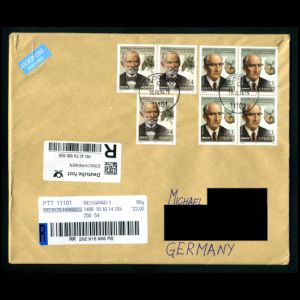 |
||
| Regular letter with both stamps of the set, shows great Serbian scientists: geologist and paleontologist Petar Stevanovic and botanist Josef Pancica. The price of big 80gr. register letter from Serbia to Germany cost Dinar 336. Due to the fact the total value of three stamps is Dinar 314 only, Dinar 22 paid by cash at post office - see top-right corner of the while label on bottom-left corner of the cover. | ||

|
References
Natural History Museum in Belgrade Back side of FDC coversAcknowledgements
- Many thanks to Ugljesa Stefanovic from Belgrade, Serbia for help finding information about these stamps.
- Many thanks to Dr. Peter Voice from Department of Geological and Environmental Sciences, Western Michigan University, for reviewing the draft page.
| <prev | back to index | next> |